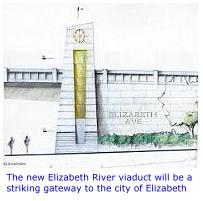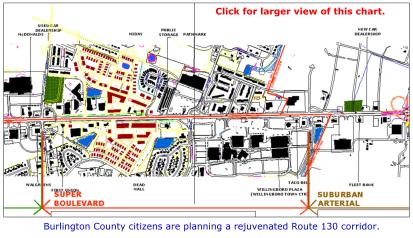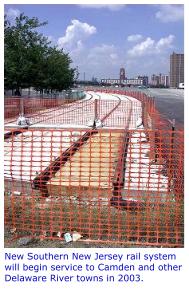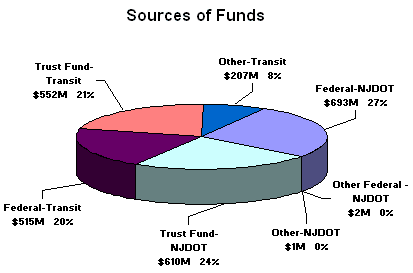"Smart
Transportation for Smart Growth"
Introduction
The Proposed Transportation Capital Program for
Fiscal Year 2004 describes all the capital investments
planned by the New Jersey Department of Transportation
(NJDOT) and NJ TRANSIT for the fiscal year beginning
on July 1, 2003. A proposed five-year capital program,
which has also been developed, which will be used as
the basis for preparing transportation improvement programs
required under federal law. Both of these programs are
the products of extensive, ongoing participation by
the state's three metropolitan planning organizations
(MPOs) and a wide variety of stakeholders. Both programs
are driven by New Jersey's transportation goals and
objectives, as laid out in this "capital investment
strategy" report.
"Capital
investment strategy" is the term used in New Jersey
for a method of linking transportation investments with
goals, objectives, and performance measures. New Jersey
is a national leader in the development of this approach,
which ensures that scarce financial resources are used
as efficiently as possible to address our most important
needs.
This
year's capital investment strategy is designed to implement the
Governor's transportation policy, especially
as set forth in Executive Order Number 43, signed at
New Jersey's First Annual Transportation Conference.
In the words of the executive order:
In
a time of limited resources it is important to identify
and prioritize transportation needs and allocate available
resources by incorporating the principles of "Fix
it First" and "Smart Growth."
This
report provides an overview of NJDOT's and NJ TRANSIT's
capital programs and concludes with a summary of the
revenues which are planned to be used to finance these
programs.
NJDOT
Smart Growth
NJDOT is committed to implementing Smart Growth
policy through transportation investments. In the words
of Executive Order Number 43, "smart growth principles
will focus and direct transportation investments into
the redevelopment of our older urban and suburban areas,
protect existing open space, conserve natural resources,
increase transportation options and transportation availability,
reduce automobile traffic and dependency, stabilize
property taxes, and provide affordable housing."
NJDOT
has a multi-pronged strategy for implementing Smart
Growth. Some of the key elements are:
Focus
investments on preserving and improving existing infrastructure
("Fix it First")
NJDOT is aggressively implementing projects
and programs that will reduce the backlog of deficient
bridges, repair highways, and ensure the safety and
integrity of our transportation system. Separate sections
in this report will detail our work on bridges, roadway
preservation, and safety.
Limit
investments in highway capacity increases
Building new roads and adding new lanes to existing
roads is the traditional solution to traffic congestion.
However, projects to build these improvements are very
expensive and can promote sprawl development. Therefore,
NJDOT has "capped" spending for highway capacity
increases at no more than 4% of the total transportation
capital program.

Combat
congestion through smarter transportation
NJDOT will pursue a variety of "smarter"
approaches to the congestion problem, including an aggressive
new program of building more park-and-ride lots to promote
transit and ridesharing. More details on the congestion
program are provided in a special section of this report.
Defer, review, and redesign projects that might
subsidize sprawl
Traffic congestion in suburban and rural areas
is often a direct result of poorly planned "sprawl"
development. Highway projects designed to relieve this
congestion can be seen as rewarding past sprawl and
encouraging more. NJDOT is reviewing every project it
is working on to identify those that might "subsidize
sprawl" if built as currently designed. Several
projects have been deferred for more intensive review.
NJDOT will work with the appropriate towns, counties,
metropolitan planning organizations (MPOs), other state
agencies, and the Governor's Office of Smart Growth
to ensure that (1) good local planning and zoning is
in place to promote Smart Growth and prevent sprawl
and (2) the project is properly designed to fix a specific
problem without causing more problems. In some cases,
a quick review will enable a project to go forward without
significant changes. In other cases, it may be impossible
to build a project that meets Smart Growth criteria.
In most cases, it is our hope that a serious dialogue
on land use and transportation planning with all the
right state and local agencies will produce a solution
that solves transportation problems while promoting
Smart Growth. An example of a successful review process
is the redesign of the planned Route 206 Hillsborough
Bypass in Somerset County. The bypass has been redesigned
to eliminate two planned interchanges and to reduce
the number of lanes in some areas. The new bypass will
take through traffic away from the planned Hillsborough
town center without encouraging sprawl development.
Promote
access to and mobility within urban centers
The proposed five-year capital program contains
funding for key projects that will promote the redevelopment
of urban centers through improved access and mobility.
These include:
 $72
million over three years for construction of a new
Elizabeth River viaduct in Union County.
$72
million over three years for construction of a new
Elizabeth River viaduct in Union County.-
Completion of improvements on Route 21 (McCarter Highway)
in downtown Newark.
- More
than $200 million for reconstruction of the Route
139 approaches to the Holland Tunnel and more than
$150 million for replacement of the Route 1&9T
bridge over St. Paul's Avenue, both in Hudson County.
- Continued
funding for local circulationimprovements in Newark,
Camden, and Trenton.
- Development
of a new "smart highway"system on the access
roads serving Trenton.
- Construction
of the University Heights Connector providing improved
access from I-280 to downtown Newark.
- Construction
of improvements at I-676 and Martin Luther King Boulevard,
serving downtown Camden.
- Landscaping
and operational improvements on Route 82 in Union
County, serving downtown Elizabeth.
Promote
open space preservation and sprawl prevention in rural
areas
New Jersey still has rural highways which traverse
farmlands and woodlands and which provide good mobility
to travelers passing through and to the residents of
the small towns and villages of the area. Many of these
rural highways are endangered by sprawl development-development
which will eliminate scenic vistas, turn farmlands into
subdivisions, erode the rural quality of life that local
residents want, and cause traffic congestion. Smart
Growth planning in rural areas can stop sprawl and maintain
mobility for the traveling public. NJDOT is supporting
a pilot project in the Route 57 corridor in Warren County
to invest in open space preservation to preserve mobility.
A $5 million investment is programmed for fiscal year
2004. These funds will be used to work with towns along
the corridor to promote development and redevelopment
in towns and villages while preserving open space in
the land between them. As funds become available, NJDOT
hopes to expand this pilot program to offer other rural
areas a chance to plan a better future for their residents
while preserving and improving mobility options for
all our citizens.
Redesign
and rebuild our suburban strips
Many of New Jersey's state highways are characterized
by suburban sprawl-strip shopping centers, fast food
restaurants, "big box" retail centers, and
jumbles of signs, driveways, and parking lots. These
suburban strips are the very opposite of Smart Growth.
The highways themselves-designed for the needs of the
middle of the 20th century-are often substandard, deteriorated,
and ill-suited to meet the needs of the 21st century.
Nevertheless, these roads carry huge amounts of traffic
and represent enormous economic investment. Leading
developers, planners, and architects around the country
have demonstrated that these older suburban strips can
be redesigned, rebuilt, and revitalized. NJDOT is supporting
a pilot project to rehabilitate the Route 130 corridor
in Burlington County in partnership with the county,
the towns, the Delaware Valley Regional Planning Commission,
and other agencies. Local citizens are actively involved
in replanning and redesigning the corridor for the 21st
century. Other corridors throughout the state-areas
along Route 46, Route 1, Route 22, Route 9, and others-are
candidates for future redevelopment efforts. The rebuilding
of these suburban strip corridors will take many years
and an enormous amount of money-money which is not yet
available. However, NJDOT is committed to beginning
this effort for the future.

Bridges
New Jersey continues to face a significant "fix
it first" challenge in bringing its roadway bridges
into a state of good repair. Our more than 5,000 bridges
provide key links for the movement of people and goods.
About 17% of these bridges (weighted for size of bridge)
are structurally deficient, meaning that they require
extensive rehabilitation or replacement. Bridges on
the designated National Highway System (Interstate and
other major highways) are in relatively good condition.
However, a small number of major, high-cost bridge improvement
projects provide a major funding challenge over the
next several years. Bridges carrying local roads are
in relatively poorer condition, but the backlog of deficient
local bridges is being reduced, thanks to the effects
of the Local Bridge Bond program and other investments.
The
proposed five-year capital program will continue a very
high investment level in bridges-about $300 million
a year. Although this investment will bring a gradual
improvement, an increased investment level would bring
a faster rate of improvement.
NJDOT
is also pursuing faster and lower-cost bridge repair
techniques, including bridge deck replacement and historic
bridge preservation projects.
Roadway
preservation
New
Jersey's state highways carry very high amounts of traffic
and, due in large part to underfunding of repair and
maintenance work over many years, require large investments
to improve their ability to carry heavy loads and to
provide a smooth ride to motorists. The proposed five-year
capital program funds a comprehensive pavement program,
consisting of various treatments for highway problems.
The pavement management program aims at implementing
"the right treatment at the right time at the right
place at the right cost." These treatments include
relatively expensive rehabilitation and reconstruction
projects for serious problems, less expensive resurfacing
projects which extend roadway life and improve smoothness,
and a wide range of lower-cost and often innovative
repair techniques.
The
funding provided in the proposed five-year capital program
will hold overall pavement conditions at approximately
current levels in the short term. However, increased
investments in roadway preservation will be needed in
the future. Many segments of our interstate highway
system are reaching an age at which they will need substantial
rehabilitation or reconstruction. A recent study undertaken
for NJDOT's pavement management system calculates that
$2.9 billion should be spent over the next 10 years
on our interstate highways to bring them all to a desirable
condition. Investments of this size are not possible
within existing and projected budgets, so difficult
choices will need to be made over the next several years.
Combating
congestion
Traffic
congestion is a problem that motorists and bus riders
face every day in New Jersey. In the words of Executive
Order Number 43, "New Jersey drivers waste 261
million hours sitting in traffic, costing each New Jersey
driver nearly $1,300 per year, negatively impacting
our quality of life and losing valuable time that could
be better spent with our families."
NJDOT
is committed to combating congestion through providing
more mobility options and smarter transportation improvements.
Some of our key approaches are:
- An
expanded park-and-ride program, with a goal of providing
20,000 new parking spaces over the next five years
to make transit and ridesharing more available to
more people.
- An
expanded signage program to provide clearer, user-friendly
information to motorists. NJDOT will expedite traffic-engineering
decision making by providing quicker service and by
delegating more decisions to county and municipal
officials.
- An
expanded program of low-cost, quick-turnaround congestion
relief projects, funded under the Fast Move program.
- An
expanded program of high-tech "intelligent transportation
system" improvements, including more low-cost,
quick-turnaround "Smart Move" projects and
engineering work for new interconnections with New
Jersey's traffic operations centers.
- Continued
concentration of NJDOT resources on the "top
10" congested areas, with planning both for short-term
and long-term improvements.
- Continued
funding for highway operational improvements, including
redesigning bottleneck intersections and traffic circles.
These projects will be concentrated in the already
congested urban and suburban areas of the state. In
fact, 56 of the 73 projects programmed for same phase
of work in the proposed five-year capital program
are located in these areas.
- Limited
funding for a select number of highway capacity increases,
including adding new lanes to existing highways and
building new bypasses. As discussed in the Smart Growth
section of this report, funding for these projects
will be strictly limited and only those projects which
meet strict Smart Growth criteria will be advanced.
- Partnerships
with counties, towns, and other agencies to address
congestion problems in rural and environmentally sensitive
areas of the state through such means as better land
use planning, better planning of access to state highways,
motorist advisory services, and carefully designed
operational improvements.
Safety
As
directed by the Governor in Executive Order Number
43, NJDOT is developing a new highway safety initiative,
"designed to reduce accidents on our highways through
improved infrastructure, driver education, and traffic
safety compliance enforcement." Some of the key
elements of the proposed five-year capital program which
advance this initiative include:
- An
expanded pedestrian safety program focused especially
on children-the "Safe Streets to Schools"
program.
- A
new "Median Crossover Crash Prevention"
program, which will significantly reduce the chances
of head-on collisions on divided highways.
- Continued
emphasis on treating the "top 10" safety
locations through a variety of short-term and long-term
improvements.
- Funding
for the installation of 500 miles of raised pavement
reflectors to decrease the number of crashes caused
by poor visibility.
NJ
TRANSIT
The proposed Fiscal Year 2004 Transportation Capital
Program for NJ TRANSIT represents the first full year
of the transition from previous commitments to a new
"back to basics" approach. It reaffirms and
strengthens priorities aimed at providing the required
resources to address the needs of the 400,000 existing
transit riders serviced by NJ TRANSIT's core system.
Much
of the proposed capital program, by necessity, fulfills
prior year commitments. The financial context in which
the program has been composed is so constrained by these
prior obligations that the setting of clear investment
priorities was essential to ensure that the available
remaining resources address critical "back to basics"
projects.
The
proposed program also supports several new priorities
that resulted from the work of the Capital Priorities
Task Force which was established to address overall
capital issues. The outcome of the Task Force work assures
that basic system safety, reliability, and capacity
needs are met on a sustained basis before any additional
large system expansion projects are advanced.
The
following priorities established the framework for Fiscal
Year 2004 and for future capital program spending:
- Meeting
all system safety requirements and mandates
- Ensuring
system reliability by meeting state of good repair
needs
- Addressing
pressing system capacity demands
- Leveraging
assets and technology for business improvement and
efficiency
- Investing
in system expansion
Back
to Basics
 In
this capital program, essential safetyand other mandates
aremet and added attention has been given to ensure
a state of good repair for the extensive NJ TRANSIT
rail network, including tracks, yards, signals, bridges,
and tunnels. During the five-year period of this program,
automatic train control and positive train stop will
have been installed on the entire NJ TRANSIT-owned rail
system. Replacement of overage buses, maintenance facilities,
trains, and repair equipment is also included. Increased
parking capacity by adding needed spaces and rehabilitating
some existing rail stations in need of repair are goals
of the proposed program. In conjunction with NJDOT,
NJ TRANSIT is committed to adding over 20,000 parking
spaces over the next five years.
In
this capital program, essential safetyand other mandates
aremet and added attention has been given to ensure
a state of good repair for the extensive NJ TRANSIT
rail network, including tracks, yards, signals, bridges,
and tunnels. During the five-year period of this program,
automatic train control and positive train stop will
have been installed on the entire NJ TRANSIT-owned rail
system. Replacement of overage buses, maintenance facilities,
trains, and repair equipment is also included. Increased
parking capacity by adding needed spaces and rehabilitating
some existing rail stations in need of repair are goals
of the proposed program. In conjunction with NJDOT,
NJ TRANSIT is committed to adding over 20,000 parking
spaces over the next five years.
Financial
Constraints
In
assessing the proposed capital program, it is important
to understand its constrained financial context. The
central financial issue is that nearly 43 percent of
anticipated resources are required to cover operating
costs, to pay debt service on projects that have been
previously financed, and to continue construction of
new light rail projects. The trend of recent years to
increase the amount of operating expenses paid for from
the capital program will continue to limit the amount
of capital resources that can be applied to actual capital
projects, such as, among others, the replacement of
22 year old diesel locomotives and 15 year old transit
buses.
The Future
The most significant challenge facing NJ TRANSIT
is the provision of capacity to meet existing and anticipated
ridership demands on the bus and rail systems. The opening
of the Montclair Connection last September and the anticipated
opening of the Secaucus Transfer this year will bring
new riders, placing continued pressure on NJ TRANSIT
to deliver a complex set of investments in parking,
yards, stations, terminals, signals, rail cars and locomotives
to meet the demands. Over time, given sustained funding,
NJ TRANSIT's program will deliver significant added
seating capacity through the addition of new Comet V
rail cars and rebuilt Comet II cars, begin operation
of new electric and diesel locomotives, and acquire
100 bi-level rail cars using $250 million provided by
the Port Authority of New York and New Jersey. (Additional
funds are being sought in order to purchase up to 131
additional bi-level cars.) As mentioned above, parking
will be increased substantially. Over three-quarters
of the 20,000 spaces that will be built in the next
five years will add capacity on NJ TRANSIT's bus and
rail systems. Planning and environmental work will continue
on the Access to the Region's Core and on the third
phase of the Hudson-Bergen Light Rail Transit System
to Tenafly, as well as other major extensions, but no
funds are currently available with which to construct
these projects.
FINANCING OUR TRANSPORTATION NEEDS
The Proposed Transportation Capital Program for
Fiscal Year 2004 is recommended to be funded at a level
of $2.580 billion. Of this amount, $1.306 billion is
programmed for use by NJDOT (51%) and $1.274 billion
by NJ TRANSIT (49%). The NJDOT amount also includes
Local Aid for counties and municipalities.
The
funding sources for this program are:
- New
Jersey Transportation Trust Fund, $1.162 billion
- Federal
Highway Administration, $766 million (including funds
"flexed" to NJ TRANSIT)
- Federal
Transit Administration, $423 million
- Other
sources, $229 million

The funding levels which have been identified for Fiscal
Year 2004 and projected for future years are clearly
inadequate to meet the transportation needs of New Jersey
in the first decade of the 21st century. With this in
mind, the Governor, in his Executive Order Number
43, established a Blue Ribbon Transportation Commission
"to examine and make recommendations on the pressing
transportation issues facing New Jersey over the next
ten years." The Commission will "identify
the means necessary to address these pressing transportation
issues and recommendations for their consideration during
the upcoming renewal of the Transportation Trust Fund."